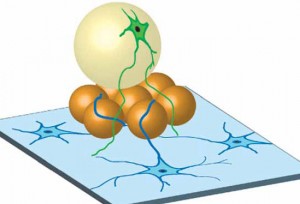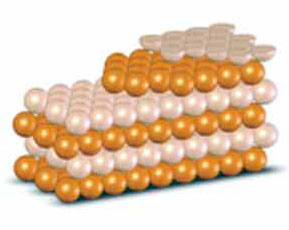Contact: Dan Krotz (510) 486-4109
How do connections form between neurons? How does an Alzheimer’s drug affect the way neurons communicate? To help answer these questions, Berkeley Lab and UC Berkeley scientists developed the next best thing to peering inside the brain. And they did it using something so simple, even a child can relate: tiny beads.
![3-d-network To learn how neural networks work, it helps to build one. This 3-D network, developed using micron-sized beads, may advance what scientists know about the brain, disease-fighting drugs, and computer architecture.]](/wp-content/uploads/2008/08/3-d-network-300x253.jpg)
To learn how neural networks work, it helps to build one. This 3-D network, developed using micron-sized beads, may advance what scientists know about the brain, disease-fighting drugs and computer architecture.
The scientists grew neurons on beads that measure several dozen microns in diameter (one micron is one-millionth of a meter). These beads assemble themselves into hexagonal sheets, which can be layered on top of each other like a stack of pancakes. The result is a three-dimensional scaffolding that for the first time allows scientists to observe neurons as they grow, connect and communicate with other neurons in all directions — above, below, and to their side — just as they do in the brain.
“Our 3-D neural network will help us understand how connectivity emerges when neurons grow, and how these connections change over time,” said Ehud Isacoff, a biophysicist who holds joint appointments with Berkeley Lab’s Physical Biosciences and Material Sciences Divisions and UC Berkeley’s Department of Molecular and Cell Biology. He developed the technique with Sophie Pautot and Claire Wyart, also with UC Berkeley’s Department of Molecular and Cell Biology.
Their technique is an improvement over current lab-based ways of studying neural networks, in which neurons are grown in a two-dimensional culture — a crude representation of an incredibly complex system.
“The brain is a multilayered structure, with billions of neurons interconnected in complicated ways. Some neurons have 100,000 connections. The more realistic the method of studying neural networks, the better we can learn how the brain works,” said Isacoff.
Scientists have long sought ways to explore how neural networks develop, and how these connections are fine-tuned as a person interacts with the world. But there’s a conundrum: neural networks are very difficult to study in the brain, and outside of the brain, they’re very difficult to replicate.

The makings of a neural connection, bead by bead. In this reconstruction, blue of axons from neurons on a coverslip encounter green dendrites from a neuron grown on a bead. The orange beads in the middle layer are coated with a substance that encourages neural growth.
The challenge is mirroring the complexity of the brain in an easy-to-develop system. Doing so could yield fundamental insights into how neural networks enable the phenomena of everyday life: seeing, hearing, catching a baseball, reading this article. Such a system could also be used to gauge the effectiveness of drug therapies that target neurodegenerative diseases such as Parkinson’s and Alzheimer’s. It could also help design computer processor architectures that mimic the brain’s ability to optimize neural networks as new skills are learned.
Currently, the most common way to study neural networks in the lab is by growing neurons on a flat surface. The technique has advanced scientists’ understanding of how neurons reach out and connect with other neurons, but it has drawbacks. It only yields a two-dimensional network, while the brain works in three dimensions. And attempts at growing three-dimensional networks on a flat surface have proved difficult. Often, a neuron dies when it’s ripped from the surface and stacked atop another neuron, or it simply settles back onto the surface.

Like a neural layer cake, the scientists harnessed micron-sized beads’ inclination to self-assemble into layered arrays to build 3-D neural networks.
“A different approach is needed. We knew that neurons grow on a flat surface. So we thought we could trick them and grow them on a spherical bead that appears flat to a neuron, just like the Earth appears flat to us,” said Isacoff.
Their idea worked. They coated silica beads with a substance that encourages neural growth. If a bead was more than 45 microns in diameter, a neuron grew on it as willingly as it does on a flat surface. Its axons and dendrites wrapped around the bead like an octopus’s tentacles.
Next, the scientists placed the beads in a solution, where they organized themselves into a highly ordered, two-dimensional array. Once an array was completed, the addition of more beads led to another self-assembled layer. In this manner, the scientists stacked the arrays on top of each other as much as ten layers high.
With this scaffolding in place, all that remained was for the neurons to do what comes naturally. Over time, the spindly axon from one neuron met the dendrite of another, forming a synaptic link. Fluorescence microscopy imaging revealed the development of a three-dimensional web of connections, as densely packed as neural networks in the brain.
“Of course the brain is much more complicated, but this is a start,” said Isacoff.
Further work using genetically modified proteins developed in Isacoff’s lab enabled the researchers to observe the flow of information from neuron to neuron, meaning the connections weren’t just structural, they were functional.
“It works beautifully. There have been attempts to do similar work, but none of them are as easy to do, and none granted the ability to design layered arrays in which the placement of each neuron can be controlled” said Isacoff. “It’s almost a trivial idea, but no one had thought of it. Anybody can obtain beads, coat them with something that neurons like to stick to, and start layering.”
Isacoff, Pautot and Wyart described their work in a paper published in the journal Nature Methods, entitled: “Colloid-guided assembly of oriented 3D neural networks.” The research was supported by the National Institutes of Health Nanomedicine Development Center in Optical Control of Biological Function.